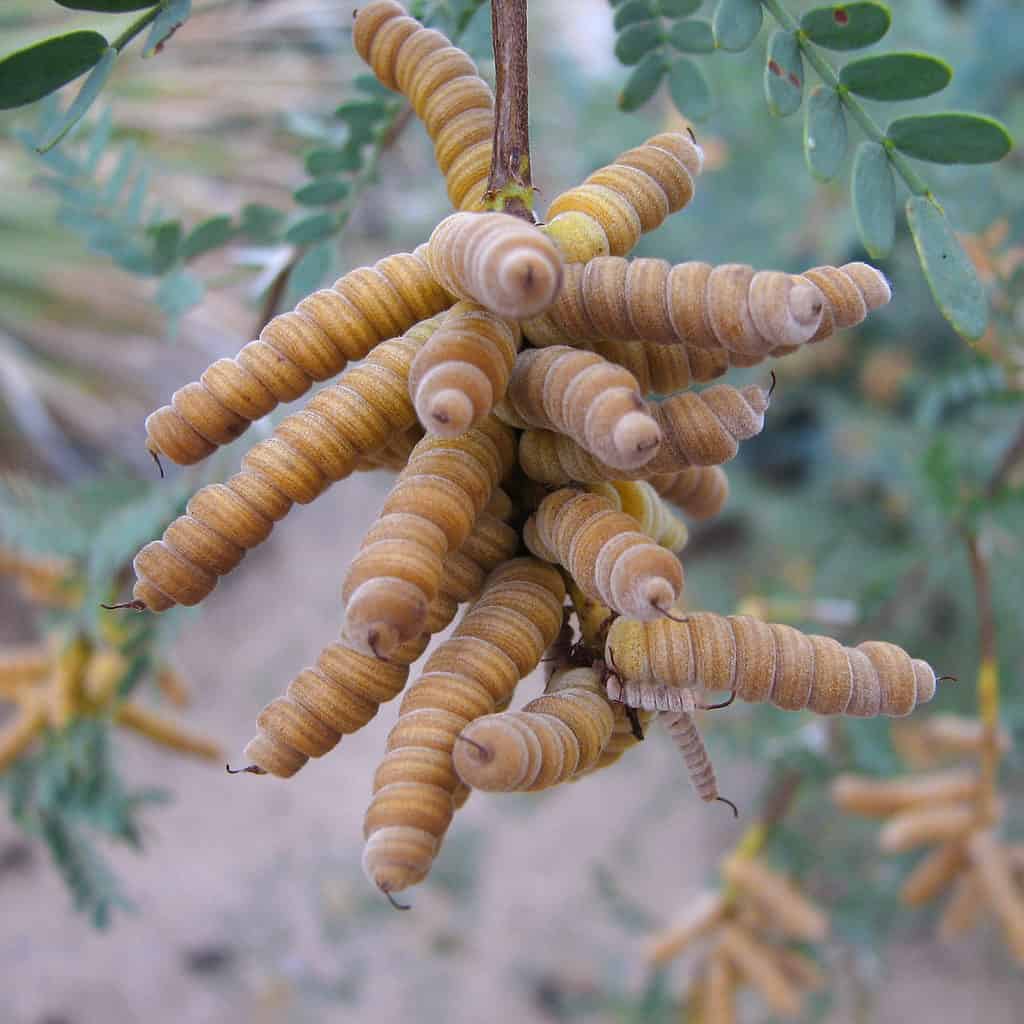When you think about Nevada, you probably don’t think of vast stretches of forest and tall trees. In fact, Nevada is the driest state in the USA, with trees only covering around 15% of the vast state. That said, trees do exist in Nevada, and they play a pivotal role in the state’s ecosystem. You’ll find about 2.5 billion iconic trees gracing the landscapes of Nevada. Notably, a large fraction of these, approximately 1.9 billion, are woodland softwoods, predominantly pinyon and juniper species. These trees add to the scenic beauty and contribute immensely to the region’s rich biodiversity.
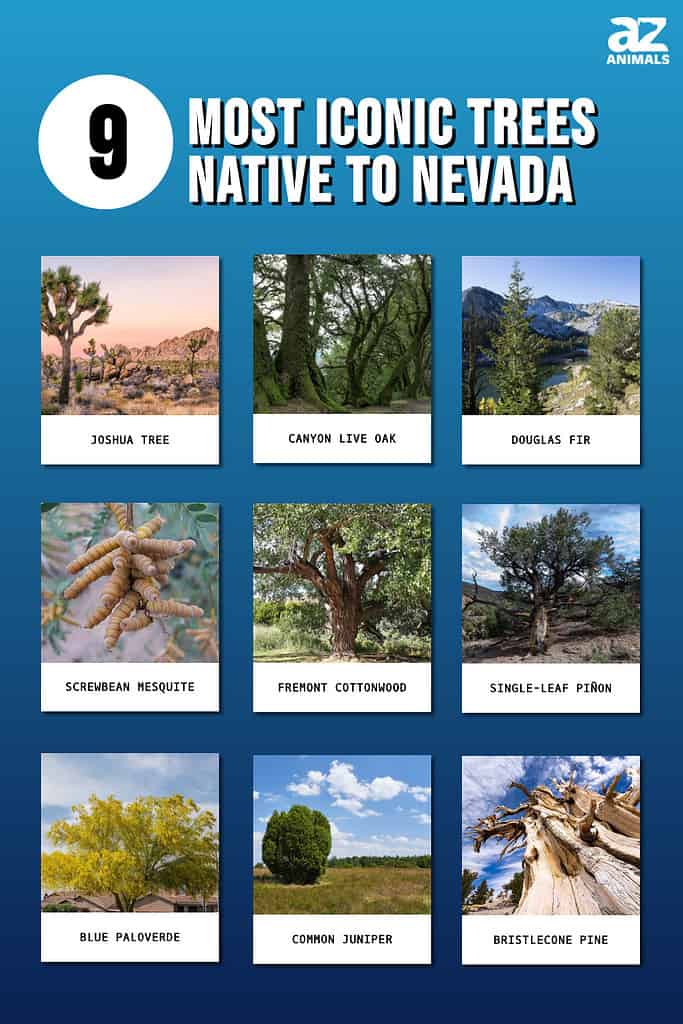
In this article, we will take you on a journey to explore some of the most common tree species in Nevada. Let’s take a closer look at these natural wonders!
What Trees Are Native to Nevada?
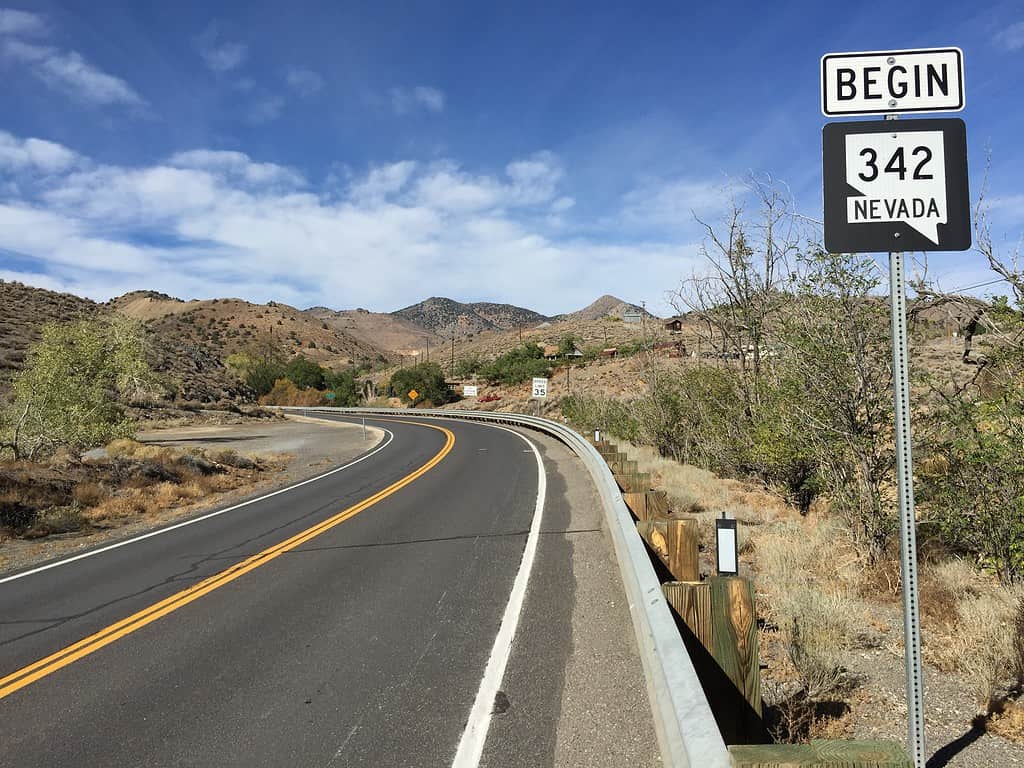
While much of Nevada is covered in desert, several beautiful trees call this arid landscape home.
Nevada boasts a unique variety of trees, some not commonly found in other parts of North America. Interestingly, the state has a large number of both native and introduced trees. However, there’s a growing concern as the already limited tree population in Southern Nevada faces a threat due to soaring temperatures.
The Utah juniper stands as a common sight in the region. You can often spot this tree in the company of pinyons or amidst sagebrush landscapes.
The ponderosa pine, a tree species with a wide presence across the western parts of North America, also calls Nevada home. Sharing a similar history with the pinyon pine, this tree settled in the region post the last ice age and usually marks its territory on the arid, rocky slopes.
Although not a genuine fir, the Douglas fir holds the title of the western region’s most precious lumber tree. You can easily recognize this tree by its flat, user-friendly, and bendable one-inch needles.
The region’s only native birch, the water birch, prefers to grow in groups close to flowing streams, generally found at altitudes ranging from 5,000 to 8,000 feet.
Lastly, the western chokecherry, a familiar face along stream beds and damp slopes, adds to the region’s rich flora.
There are two official state trees of Nevada: the bristlecone pine and the single-leaf piñon.
1. Joshua Tree (Yucca brevifolia)
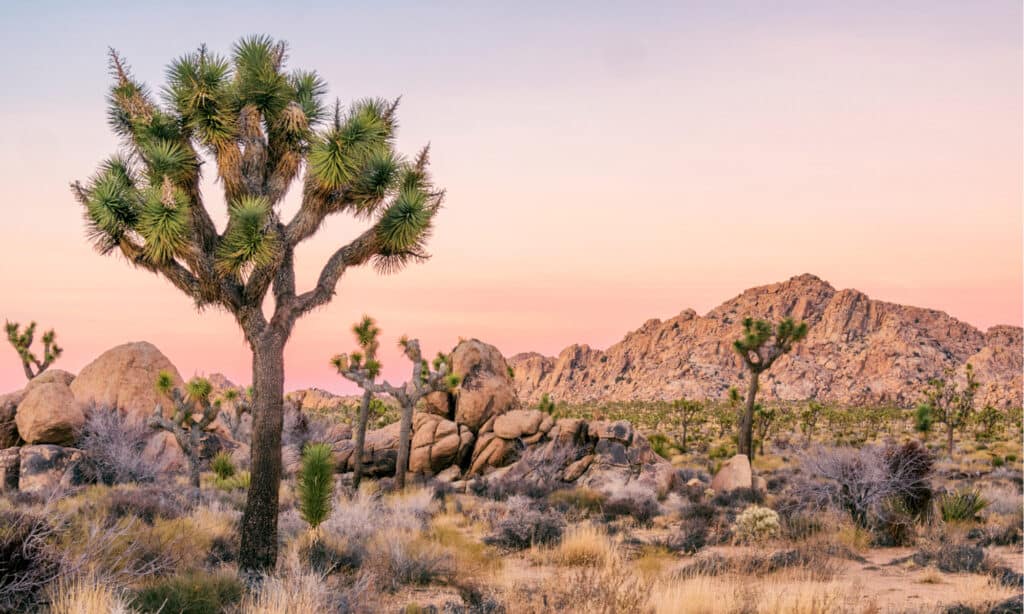
One of the most interesting desert trees is the Joshua tree.
©Dennis Silvas/Shutterstock.com
The Joshua tree is one of Nevada’s most iconic native trees. This unique tree exhibits a tall and sturdy stature, thick branches, and a spacious, rounded top. Its leaves are sharply pointed and narrow, displaying a grayish-green color and grouping near the ends of the branches.
The Joshua tree holds onto its aged, wilted leaves, which end up covering its trunk and stems. When spring arrives, the tree boasts spectacular flower clusters at its tips, spanning nearly 20 inches and showcasing greenish-white flowers that rely on moths for pollination.
Notably, the Joshua tree can thrive for over a century and a half, serving as a vital resource for wildlife. Approximately 25 different bird species find refuge in these trees for nesting, and numerous small animals feed on its seeds.
Growing only in a few states of the US, the Joshua tree thrives in the arid Mojave Desert. It is an exemplary addition to gardens that emphasize drought-resilient plants or those styled after the desert landscape.
This tree can reach heights and widths ranging from 15 to 30 feet. Thriving in sunny environments, the Joshua tree prefers soil that is coarse and dry, with good drainage. Its resilience to drought makes it a relatively low-maintenance addition to gardens.
2. Canyon Live Oak (Quercus chrysolepis)
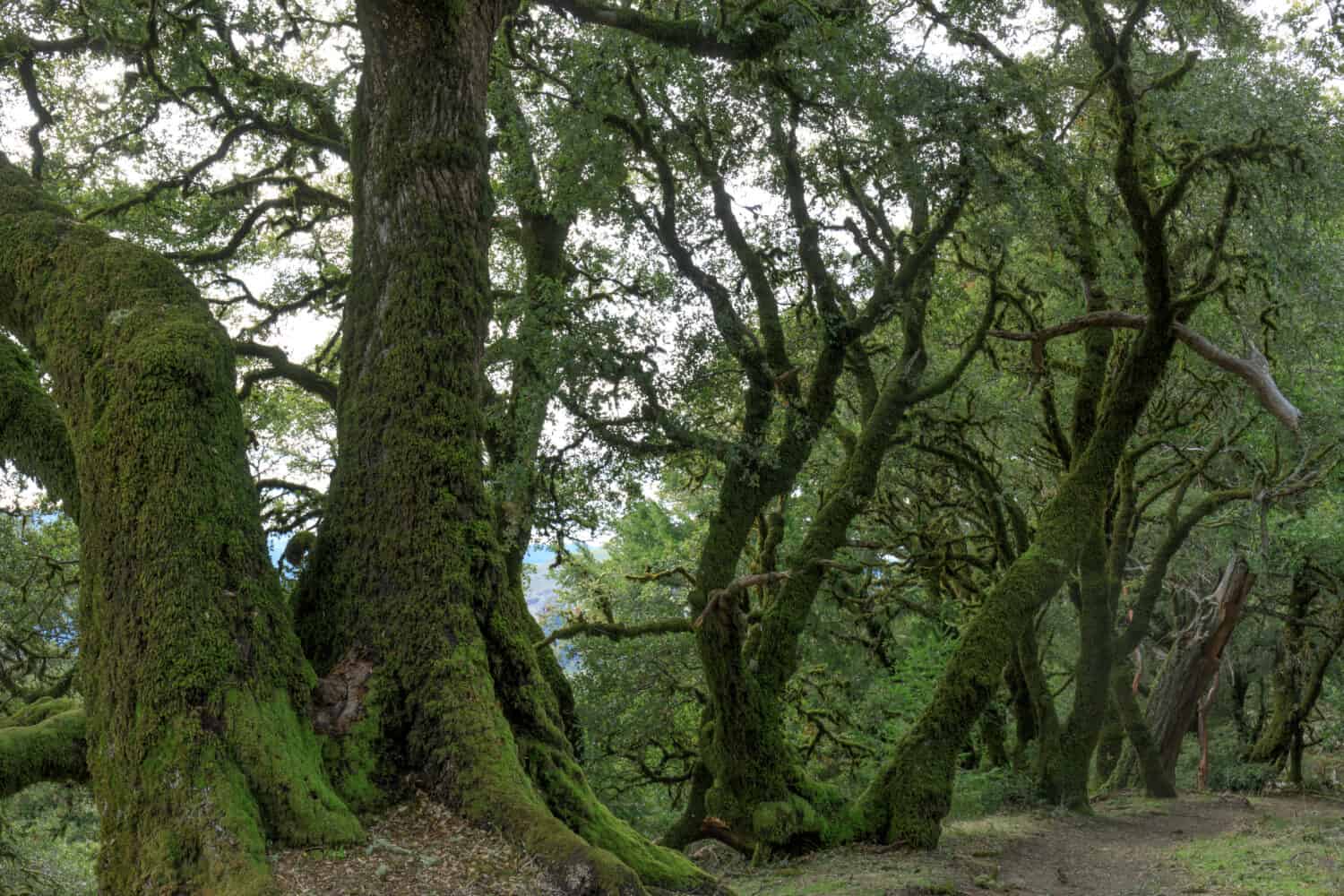
Growing to over 80 feet, the canyon live oak is a beautiful tree that is native to Nevada.
©yhelfman/Shutterstock.com
The canyon live oak can thrive for as many as 300 years, often taking root in protected, damp canyons. Its expansive and lush crown stretches outward, nearly touching the ground, and presents a dense canopy. While young stems feature smooth or slightly flaky bark, the larger stems have a more rugged, deeply grooved appearance.
The tree’s leaves are sturdy and oblong, measuring up to 4 inches in length. In its youth, the tree tends to have spiny leaves, which become smoother as it ages; interestingly, both leaf types can be observed on a single tree. Depending on individual characteristics, the leaf colors can range from a bluish-green to a rich, dark green gloss.
In terms of flowering, the male blooms present themselves in clusters, whereas the female blooms are either isolated or found in sparse, floral spikes. The canyon live oak is particularly resilient to dry climates, owing to its deep, sprawling roots that manage to tap into underground water reserves during the arid summer months.
This tree serves as a picturesque addition to urban settings. It predominantly grows in canyon areas, moist slopes, or neighboring stream banks within Nevada.
Standing tall between 30 and 80 feet and spreading out 30 to 60 feet wide, this adaptable tree enjoys both full sun and partial shade. It grows well in various soil types, ranging from highly acidic to slightly alkaline, including well-draining loam, sand, or clay soils.
3. Douglas Fir (Pseudotsuga menziesii)
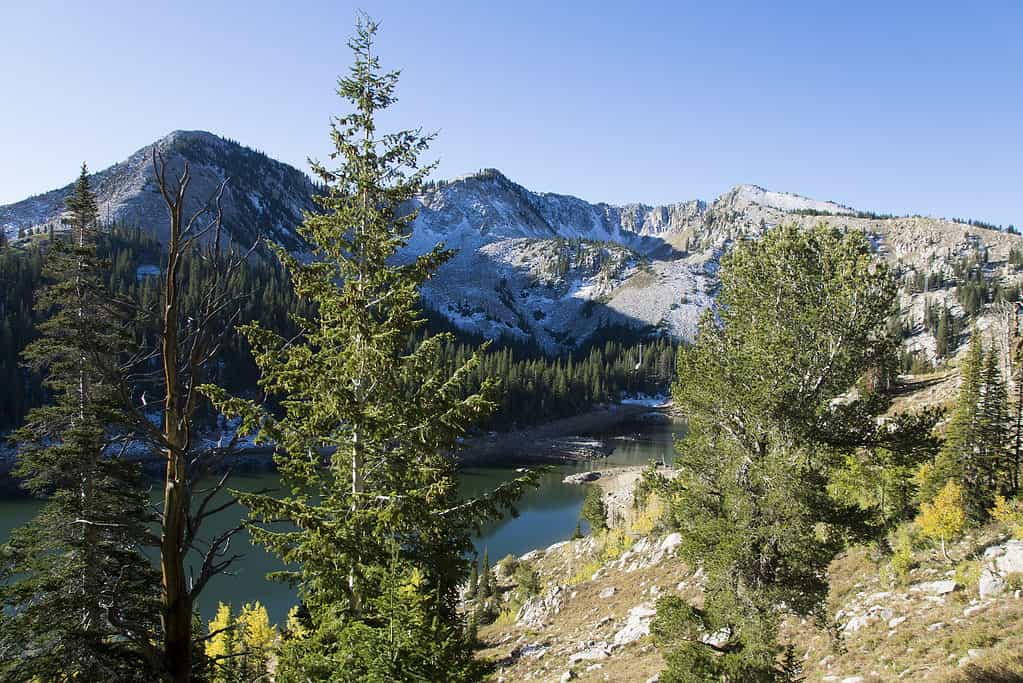
Small Douglas firs are one of the most common Christmas trees in the USA.
©IrinaK/Shutterstock.com
The Douglas fir is a splendid evergreen tree that naturally takes on a pyramid-like shape. This evergreen has hanging lower branches and upward-reaching upper branches in its early years. As it matures, it adopts a more uneven conical form, shedding its lower branches in the process. Its needles, which arrange themselves in a flat spiral pattern, display a rich green or bluish-green color and span around 1.5 inches in length.
This tree is notable for bearing numerous hanging, egg-shaped brown cones that measure about 4 inches in length. These cones are easily recognizable due to their distinctive forked bracts, resembling festive decorations hanging from the branches. Initially sporting smooth brown-gray bark, the tree undergoes a transformation as it ages, developing a reddish-brown, thick, and rugged exterior. A native to the western regions of North America, the Douglas fir grows at a slow pace, adding approximately a foot to its height each year.
It is rare to spot a Douglas fir in the southern regions of Nevada.
This tree can reach a stature of 40 to 80 feet tall and spread 10 to 20 feet wide. Additionally, they thrive in areas with full to partial sunlight. It prefers slightly acidic soil that can retain moisture well, along with good drainage properties.
4. Screwbean Mesquite (Prosopis pubescens)
The screwbean mesquite is a deciduous tree in Nevada with an elegant vase-like structure. This tree has elongated, thin branches and a sparse canopy adorned with delicate, blue-green leaves. These leaves are double-compound, with each small leaf stretching up to 3 inches long, hosting 5 to 9 pairs of tiny leaflets.
The branches have sharp, thin spines that are about an inch long, situated at the base of each leaf. During the late spring and into mid-summer, the tree blooms with soft yellow flowers grouped in slim clusters. As the season progresses, these flowers give way to attractive gatherings of spiral-shaped pods, each about 2 inches long, encapsulating numerous seeds that serve as nourishing feed for both livestock and wildlife.
Known for its modest water requirements to reach full growth, the screwbean mesquite is an ideal native choice for Nevada’s landscape, often spotted within the confines of the Las Vegas Springs Preserve.
This tree flourishes in sunny environments, reaching heights and widths between 8 and 30 feet. It demonstrates hearty adaptability to various soil conditions, thriving in everything from dry to moist grounds with good drainage, and can tolerate an array of soil types, including light sandy to dense clay textures.
5. Fremont Cottonwood (Populus fremontii)

Growing very well in the arid climate of the Southwest, Fremont cottonwoods are a beautiful and large tree.
©C Belt/Shutterstock.com
The Fremont cottonwood thrives in various regions of the Southwest, including Nevada. You can also find this tree spreading its roots in California and even Mexico.
This rapidly growing tree sports an upright structure adorned with thick branches that host bright green, heart-shaped leaves. These leaves transform into a charming shade of yellow as fall approaches. As the tree matures, its ash-gray bark forms into broad, flat ridges, which are segmented by profound crevices.
However, one needs to be cautious with its planting location, as the tree tends to develop a sprawling root system that can disrupt sidewalks and potentially harm sewer lines. Despite this, it serves as a vital habitat for birds and butterflies, offering a refreshing shade canopy. It is best suited for vast spaces, preferably distanced from residential premises or in countryside locales beside water bodies, where other sizable trees might not thrive as well.
You can find Fremont cottonwoods lining the lower regions of the Truckee River, specifically from Reno flowing down to Pyramid Lake.
Reaching towering heights between 40 and 80 feet, the Fremont cottonwood is a large tree. This tree adores the full sun and flourishes effortlessly in medium to wet, well-drained soils, whether loamy or sandy.
6. Single-Leaf Piñon (Pinus monophylla)
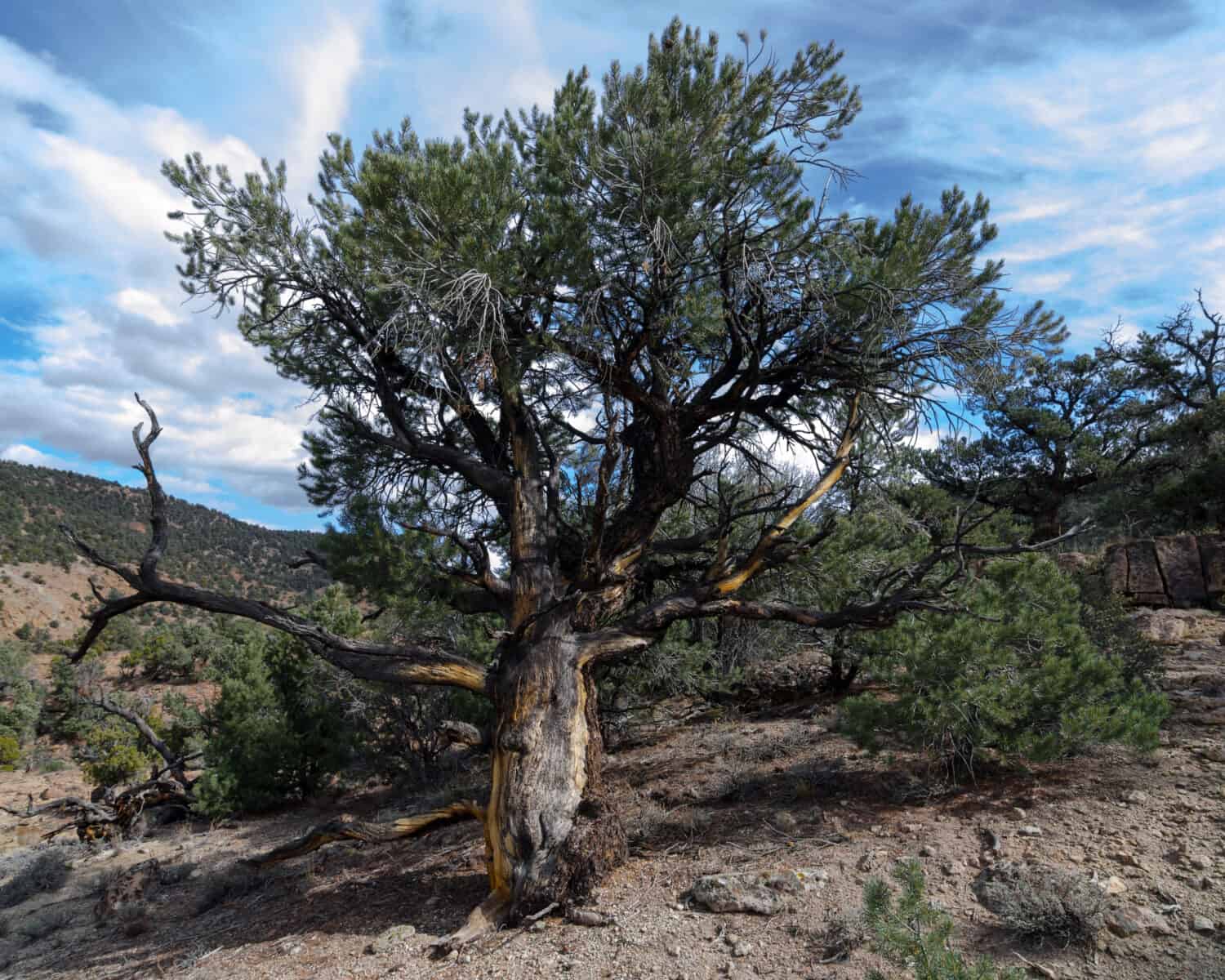
The single-leaf piñon is one of the two official state trees in Nevada.
©Dominic Gentilcore PhD/Shutterstock.com
The single leaf piñon is a modestly sized evergreen tree native to the southwestern regions of North America. Known for its hardy nature, it grows very slowly, topping off at around 60 feet. Interestingly, the single-leaf piñon is the only pine tree with one needle on each branch!
In their early stage, these trees possess wide, cone-shaped crowns, evolving over time into either sprawling or leveled canopies. One of the standout features of the single leaf piñon is its production of small, brown, nutritious seeds, commonly referred to as pine nuts, housed in sturdy cones.
It is one of the two official state trees of Nevada. Additionally, the single leaf piñon lives for a very long time. Some individuals have been known to live for over 1,000 years!
Thriving in an array of soil types, the single-leaf piñon shows a preference for sandy soils with good drainage properties. A lover of sun-soaked locations, it thrives best under abundant sunlight. While choosing a planting site, opt for a sheltered spot to minimize potential wind damage.
7. Blue Paloverde (Parkinsonia florida)
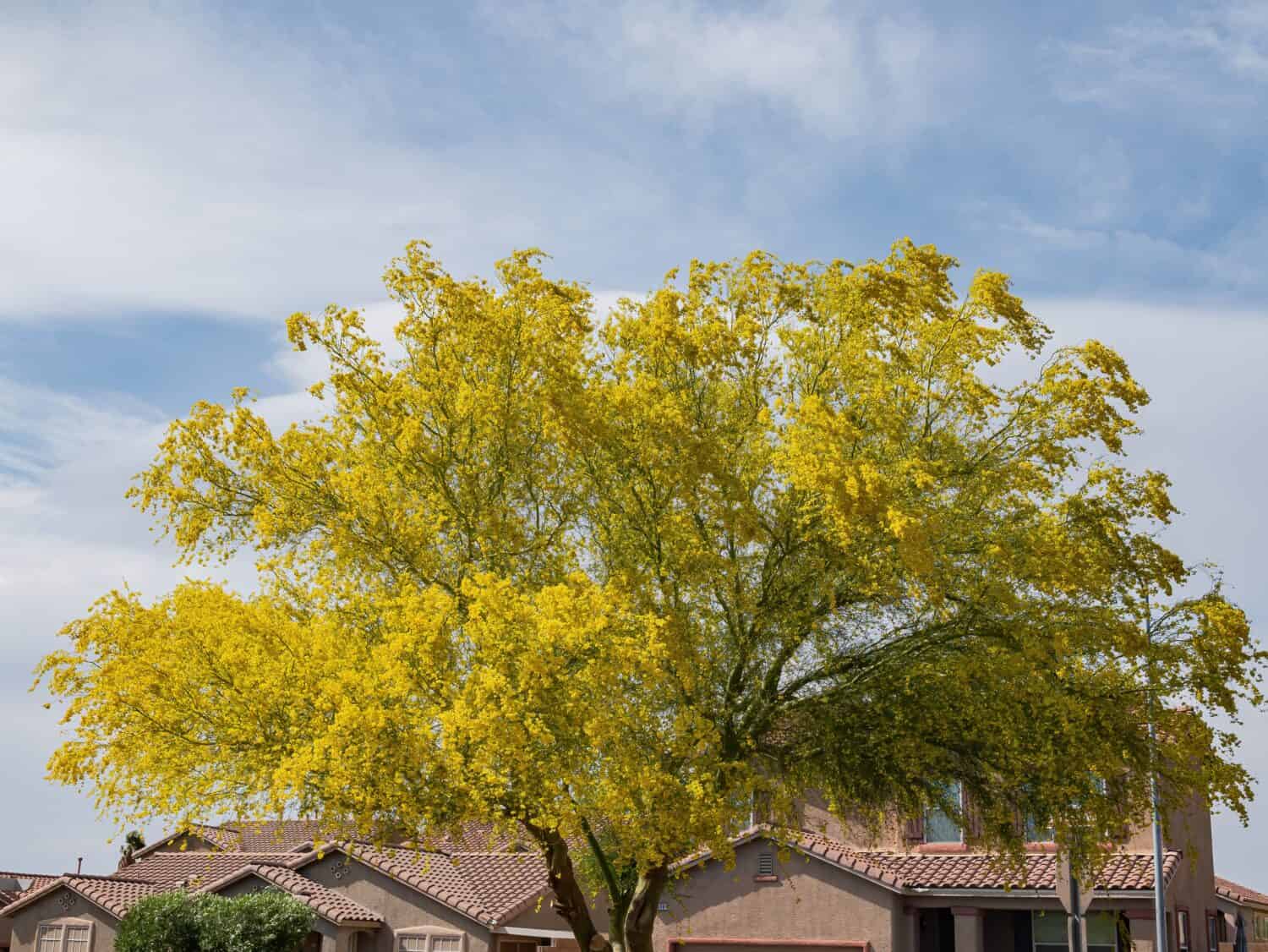
The blue paloverde grows beautiful flowers and thrives in southern Nevada.
©Kit Leong/Shutterstock.com
A favorite among desert garden enthusiasts, the blue paloverde is an elegant tree characterized by its blue-green trunk that is relatively short and a canopy that spreads out loosely. While this tree may look evergreen, it is actually deciduous. It sheds its small, feather-like, blue-green leaves for the better part of the year to adapt to arid conditions.
The tree utilizes its smooth, spine-accented, blue-green branches and twigs for photosynthesis. During the spring season, the tree transforms. Clusters of golden-yellow blossoms spanning 2 to 4 inches in width bloom all around the tree. This stunning floral display often extends into the midsummer, especially if the region is blessed with rain.
The blue paloverde is aesthetically pleasing throughout the year and particularly captivating when in bloom. Additionally, it holds the honor of being Arizona‘s official state tree. In Nevada, it is typically found in the dry washes of the desert, along floodplains, and within canyons.
Reaching a height between 20 and 25 feet and a width of 15 to 20 feet, this sun-loving tree thrives in well-draining soils, ranging from loamy to sandy textures, with a tolerance for neutral to alkaline soil conditions.
8. Common Juniper (Juniperus communis)
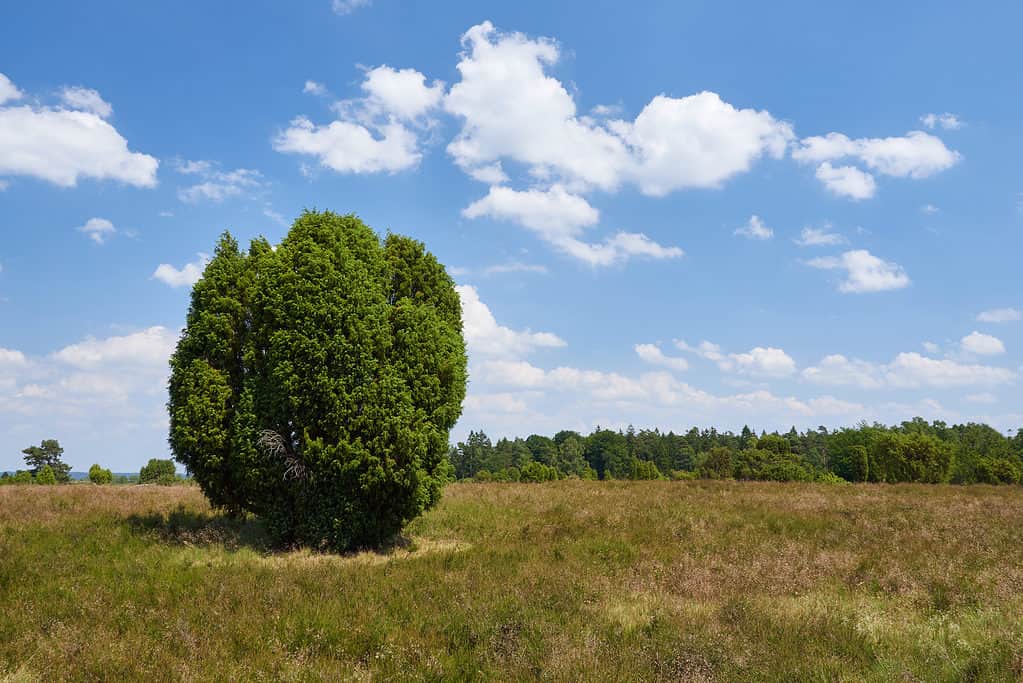
Junipers are widespread across much of North America.
©Thomas Marx/Shutterstock.com
Perhaps one of the most widespread trees globally, the common juniper is found across Nevada. Its leaves are aromatic and sharp and have a needle-like structure throughout their lifespan. Additionally, the leaves present themselves in clusters of three, which is quite different from other juniper species that have scale-like leaves as they age.
This juniper variant has distinct male and female plants. Each with small yellow blossoms in the spring. Female plants then develop small, berry-esque cones that transition to a deep blue or black color, with a waxy texture come fall. These juniper berries serve as a food source for various wildlife, including numerous bird and mammal species.
Though not abundantly found in Nevada, a handful of these trees can be spotted dispersed across the Spring and Sheep Mountains. The Bristlecone and Mummy Spring trails offer the best sighting opportunities for those looking to witness this species in the Spring Mountains. Another notable habitat for this tree is Harris Mountain.
These trees only grow to around 30 feet tall and have a diameter of around 3 feet. It thrives under the full sun and adapts well to many soil types.
9. Bristlecone Pine (Pinus longaeva)

The bristlecone pines of the Great Basin National Park are the oldest trees in the world.
©iStock.com/Riderolga
The final tree on our list of iconic native trees in Nevada is the bristlecone pine. Many scientists think This amazing tree is the oldest organism on Earth, with some specimens living for over 5,000 years! Bristlecone pines are extremely slow-growing. In fact, a 50-year-old bristlecone pine may only be 8 to 12 inches tall! Unfortunately, this spectacular pine is rare and can only be found in three states (Nevada, California, and Utah). The oldest living bristlecone pine, Methuselah, is expected to be around 5,000 years old and lives in the white mountains in California.
Depending on the weather conditions and elevation, these trees will grow between 30 to 60 feet tall. They will grow to a maximum height and then continue to grow wider as they age.
Summary of the Most Iconic Trees Native to Nevada
| Number | Tree | Average Lifespan |
|---|---|---|
| 1 | Joshua Tree | 150 years |
| 2 | Canyon Live Oak | 300 years |
| 3 | Douglas Fir | 1000+ years |
| 4 | Screwbean Mesquite | 40-110 years |
| 5 | Fremont Cottonwood | 70-100 years |
| 6 | Single Leaf Piñon | 600 years |
| 7 | Blue Paloverde | 150 years |
| 8 | Common Juniper | 350-700 years |
| 9 | Bristlecone Pine | 5,000 Years |
The photo featured at the top of this post is © Dominic Gentilcore PhD/Shutterstock.com
Thank you for reading! Have some feedback for us? Contact the AZ Animals editorial team.




